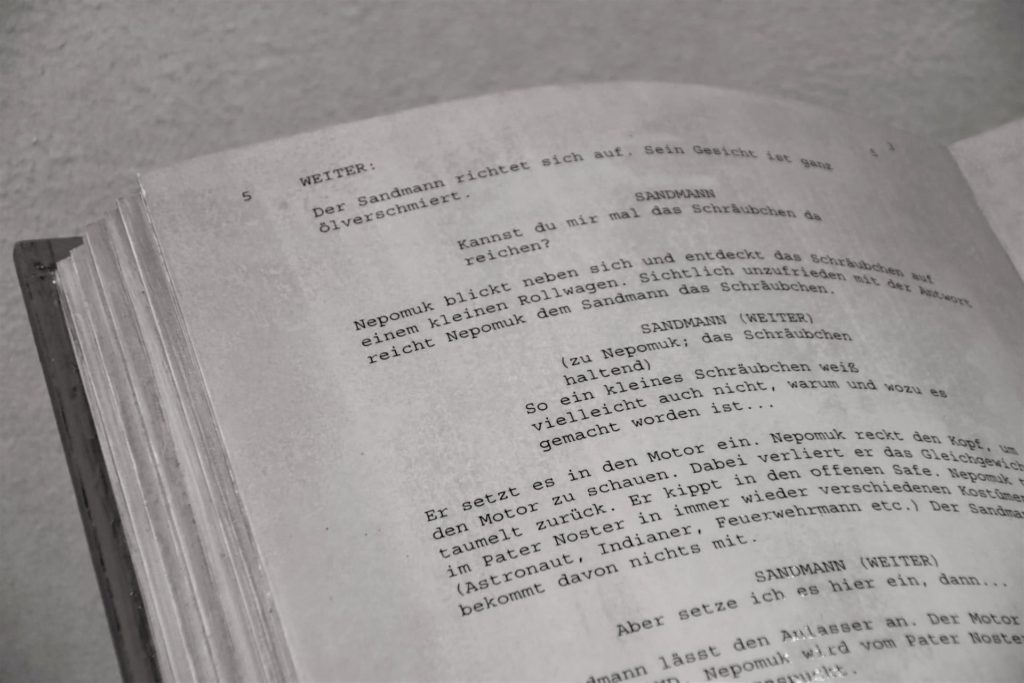How to Turn a Story Idea into a Script
Before you embark on the long and arduous yet thrilling journey that is writing a screenplay, you should make sure you have a solid story idea.
Who are my characters? Are they complex and multi-dimensional? Does there exist enough conflict and stakes to drive the story along? These are some important questions you should consider before jumping into a script.
If you’ve been struggling with coming up with story ideas, check out our previous post where we discuss the crucial elements that make up good story ideas that producers and directors will listen to.
Also, if you have an idea or a script you’re looking to put to screen, but lack funding or resources, take a look at our funding opportunities for the chance to win up to $10,000 for your film.
Once you’ve thought about and developed your narrative story idea, it’s time to start actually writing. This can seem daunting at first, especially if you haven’t written a screenplay before, but don’t be discouraged. In this post, we’ll list a few tips on how to turn your idea into a full-fledged script.
Understand Proper Screenplay Format

Industry professionals, established competition judges, and movie producers reading your script give little room for error — typically in format and structure.
You don’t want people reading your script tossing it after the first page simply because of technical issues. This is why it’s important to learn how to properly format a script so that people will take your work seriously.
You don’t want to spend countless hours and days working on a script only to be disregarded because you formatted your slug lines and dialogue incorrectly.
There’s plenty of free and premium scriptwriting software that will help structure and format your script within industry standards. The most well-known and used software used by working professionals in the film industry is Final Draft. If you have the funds for writing software, it would be a great investment if you’re serious about writing a professional-looking screenplay.
We even wrote a post on why proper formatting is important (and one that shows why it’s not always important).
Learning how to properly format a script will allow you to worry less on the technicalities of writing a script, and more on the story.
Create a Logline
When you think you have a compelling and creative story idea, it’s time to start writing the script. But before you begin writing, a great way to help you grasp what your actual story and conflict is essentially is to create a logline.
A logline is essentially a one-sentence summary of your screenplay that includes your main conflict and how it relates to your protagonist/antagonist.
Your logline also acts as a one sentence pitch to film producers and directors, as well as any potential investors, interested in reading your script. The logline will help them determine whether or not they want to actually go forward with reading your script. So writers typically try to create a hook within their logline to generate interest and curiosity.
The overall goal of the logline is to make people want to read your script and to help you understand what your story will be about.
Crafting a logline is incredibly similar to submitting a pitch to one of our one-sentence pitch contests, so be sure to check them out if you need to fund your short film.
Make an Outline

Once you’ve crafted a compelling logline for your script, you should construct an outline.
An outline will help you immensely with organizing and breaking down your script. Whether you plan on using flash cards, a whiteboard, or a word document, an outline will help you map out and structure the order and sequence of your scenes.
Deciding to write a screenplay can be very daunting. You don’t want to begin writing and not know where to go after a particular scene. This is why thoroughly mapping out your story before you write, will save a lot of time and stress down the road.
Choose whatever works for you — whether it’s with flash cards or a word document. Try to structure your outline with the three acts of your screenplay and where certain scenes, plot points, and important character moments occur. The more detailed the better.
If you’re interested in using software, Final Draft has great prewriting tools to help you with outlining your screenplay. They have a Beat Board and Story Map tool that can help you with page-by-page and beat-by-beat outlining if you want to a construct a more detailed outline.
Write a Treatment

Similar to a logline, a treatment is a summary of your screenplay, but much longer (generally between 10-20 pages depending on the project) and typically written out in prose like a short story.
It also can be used for marketing purposes, much like a logline, when either pitching or trying to sell a script. Executive producers may want to read a treatment first when deciding to read a script — so it’s important that you take the time to write one.
Not only is a treatment good when trying to sell your script, it’s another great prewriting exercise to help you get a better grasp of your story.
Writing your entire screenplay in short prose can be a great way to see how your story flows on the page, as well as how your characters and conflict change and develop throughout the story. Pacing and structure is an important aspect of your script, and a treatment can help you see the tension and conflict progresses from scene to scene.
Write the First Draft and Make Revisions

Once you’ve garnered a firm understanding of scriptwriting format and the prewriting process, it’s finally time to take a dive into writing the screenplay.
And I know I’ve mentioned this before, but even after completing a well thought out outline, treatment, and logline, getting started on your screenplay can be daunting. But that’s the beauty of writing your first draft. It’s meant to flawed and ridden with mistakes.
In order to write a great screenplay, you need to write a bad one.
The point of the first draft is to get all your initial story plot ideas, character arcs, pacing, style, and structure down so that you can go back and make changes several times. All of the great screenwriters currently working in the industry go through several drafts before it even reaches the screen. So don’t be discouraged during your first draft. Know and accept that it will have mistakes so that you can spend less time worrying and stressing, and more time writing.
In remember, when writing a screenplay, it’s important to adhere to the general rules of structuring and pacing — such as using the three-act structure, plot points, and the correct page count for certain sections of the story. However, don’t stress about this. These are suppose to be guiding tools for writing a story, not limitations.
Tell the story you want to tell and how you want to tell it. There are many great scripts written by successful filmmakers that deviate from typical screenwriting story structure.

It’s also important to note that when writing a screenplay, know the type of story you’re telling because the style of writing typically changes depending on the genre.
For example, if you have a horror story idea and you’re starting the script, understand, stylistically, how to create suspense and horror in your writing. Take a look at some well known horror film screenplays to see how those writers create unsettling feelings and suspense for the reader.
And lastly, if you’re unsure of the title, it’s better not to stress about story title ideas until after you’ve finished the screenplay. This is because often times, as you write, you will discover new ideas, themes, and character traits you haven’t thought of before writing. Waiting until after you finish the story can give you a much better idea for the title.
All in all, don’t be afraid to start writing the first draft. Writing a great screenplay takes a lot of time, effort, and revisions. No one’s perfect the first time they begin writing. And you don’t need to have gone to a film school to write a screenplay. Many of the best filmmakers today never step foot in a classroom and they’ve written some of the best stories we all know and love.
So, if you have a great fictional story idea, don’t hesitate to turn into a screenplay.
Don’t forget to check out our funding opportunities for the chance to receive funding up to $10,000 and other prizes if you’re interested in getting your idea or script developed into a film.
That’s good, I am on the process of writing one.thanks for the idea.
You’re very welcome! 🙂
I wish I’d stumbled on to this a few weeks ago, I handed in my script which was my exam and I discovered a couple of errors ,but thanks atleast I’ll have an idea going into my next script.
So glad you found it useful for the future!
This is good.am fulled with excellent stories,but do not know how to write them down.this will definitely help.
Thanks
So glad you found it useful!
I read that most production companies will not even read a script unless an agent/ manager has recommended it. Do you suggest sending off for script notes/ coverage first and keep working thru drafts, then submit to agents or what?
Hi, Stu. Thanks for your comment! It really depends on the production company, but yes, a lot of the time companies will not accept unsolicited material. I would recommend working through drafts as much as possible, then getting coverage, and then submitting to script contests. Although, keep in mind we are not script consultants here, just what I would do myself as a writer! 🙂
Hi, thank you for this post. I have a book that’ll be really good for a movie but I don’t know how to pitch my story to publishers. If anyone can help me with this, that’ll be great.
Thank you.
Hi Osaze,
Thanks for your comment! We can’t help with contacting publishers, unfortunately, but be sure to search our blog for tips on pitching in general!
Hello! Great article! It definitely highlights the processes and even more the struggles that I have experienced with writing my first screenplay, in which I haven’t worked on due to mainly my own inability to deal with working thru that uncomfortable feeling of not knowing what to do next ( its a thing with anything artistic wise)and not finishing what I start, but life stuff happened too. There was also the circumstances of how it came to past, being a product of two people whom no longer are associated with each other both personally and professionally. BUT….after reading this, it let’s me know that I should trust my creative spirit and FINISH what ever step I may be on! Peace!
Fade In (free version) is a good choice for beginners. For me it’s use on a tablet is limited, but on a laptop or desktop, it’s in the butter zone. It sets up margins, formats etc….you can choose screenplay, stage play, tv script etc..
And it’s free.
Thanks for the suggestion, George!
I’ve written a story – a LGBT remake of a favorite classic film of mine. Currently it is in story format – 266 pages. I know I will run into issues regarding screen rights and all of that. But for now, I want to turn it into a credible, readable screenplay. I’ve let a few friends read it and they say that it sounds promising. Who can help me?
Hi there! Thanks for reaching out. When you enter our contests, you also join a community of filmmakers and producers who you can chat with about your projects. You may be able to find someone there.
Greetings
Have written a story, made into script, budgeted for one film, can be released world wide,..
It’s about son searching for his unknown mother,….but his story takes to another level,
How he met his girl friend, After their life journey, why his girl killed his unknown mother, why he killed the witness, …and who was she and what was he..????. That’s the movie..
Thanks for your comment! If you’d like to submit a pitch to The Film Fund, you can do so here.